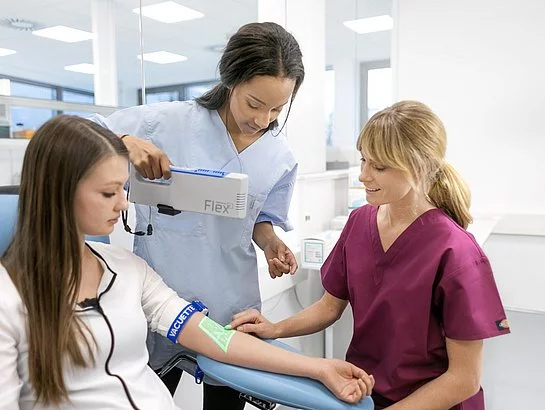How to stop needle fear before it starts: 10 step-by-step tips from an experienced nurse
Last edited: | Safe Blood Collection - Back to overview
In our fourth article exploring fear of needles, we share the specific practical steps that healthcare professionals can take to master the art of calm, efficient and safe venous blood collection. Our teacher is Andreas Mayr, (Master of Science in Nursing) who has trained thousands of clinicians and nurses in safe venepuncture during his 30-year career.
As a lifelong diabetic, Andreas is no stranger to the fear of needles himself, having endured years of painful venepuncture techniques as a child. Sadly, as for many, these unpleasant experiences have left their mark. “An important cause of needle-fear is bad previous experiences” explains Andreas.
1. Know the impact of fear on a vein
It's important for the patient to be as calm as possible because if the patient is afraid, he has adrenaline in his veins, which makes them constrict” says Andreas. It’s the classic flight response and it can increase the chance of cutting the back side of the vein and causing a haematoma.
2. Prepare your working area
A hygienically clean working area is of course essential, but consider how your workspace is arranged from a practical perspective too. The position of your equipment should support the smooth choreography of the procedure, minimizing the need for hands to cross which can increase the chances of needlestick injury. And it all alters depending on whether you’re left- or right-handed.
If you are right-handed” says Andreas, “you have the needles on the right side so you can manipulate the tourniquet and the tubes on the left. As a left-handed person, it's the other way around.” And remember that to avoid accidental secondary puncture caused by swapping hands or crossing arms, your sharps disposal container should always be on the same side as your needle – the dominant arm with which you puncture.
3. Keep the needle bevel facing up
There are two almost separate processes performed by the needle in venepuncture. Andreas explains: “When you puncture, the bevel of the needle should always look up because the needle sticks and the needle cuts, and the stick must be perfect.”
4. Do not apply pressure
The average hospital scenario will have you believe it’s best practice to press down on the gauze pad, which then also results in pressing down the needle when the blood drawing staff are finished and remove the needle. This is not only uncomfortable, it increases the chance of damaging the patient's vein tissue.
5. The right product combination is crucial
Andreas explains “There are different kinds of needles and different kinds of tubes. The wrong product combination for the vein condition can cause a problem.” When working with the elderly for example, you need a thin needle and a low vacuum tube that fills slowly. “The right tube for the right patient and his vein conditions” explains Andreas.
6. Choose the right needle gauge for every vein
Before you start you need to decide how thick the vein you are working with is, and therefore how big the needle needs to be. “Normally” says Andreas, “you're using a 21 gauge needle, but for thinner veins [usually occurring in children, the elderly or dehydrated], you need thinner needles with a higher gauge.”
7. Keep the patient’s arm slightly bent
People tend to think that the vein is better ‘fixed’ in a stretched-out arm but imaging equipment reveals that having the arm stretched out actually flattens the vein, making it harder to achieve a successful draw and increasing the chance of the needle cutting the back wall of the vein.
8. Pull the skin taught
“If you pull the skin a little bit taught it makes it easier [for the bevel] to enter the skin” says Andreas. This technique minimizes pain and increases the chance of executing a smooth-running procedure from this point.
9. Insert the needle at an angle of less than 30 degrees
Imagine the elbow of a patient. “The vein is going in a kind of bow up to the skin and then down again” explains Andreas. To avoid damaging the far wall of the vein, “the needle should be inserted at a flat angle (of less than or equal to 30 degrees)”. “But” guides Andreas, “this is different for each patient and each vein condition”.
Try not to fall into the trap of thinking that a patient will be scared if you use a long needle. Explain to them that you don’t insert the needle the whole way and that a longer needle is better for the angle of insertion which makes the procedure safer for them.
10. Do not insert the whole needle
Whichever needle you choose you should know that you don’t need to push it all the way into the skin. It isn't necessary for an effective draw, increases pain and can damage delicate vein tissue too.
Tackle some of these common misunderstandings about effective venepuncture and not only are we helping to prevent negative needle experiences, we create the conditions for calmer, more efficient and safer procedures: reducing the incidence of nervous patient-nurse interactions, increasing the likelihood of ‘right-first time’ blood collection and, crucially, minimizing the risk of dangerous needlestick injury, haematoma, and blood borne diseases for nurses and patients alike.
With thanks to Andreas Mayr
Andreas Mayr, (MSc, Nursing) is an Intensive Care nurse with 30 years of experience. He carries out his venepuncture safety training work for Greiner Bio-One, a blood-collection consumables provider who many associate with safety.
But for Andreas, the issue of needle-fear has an additional layer of complexity. “I am still scared today, when a nurse or a doctor takes my blood”, he confesses. Not simply because of his personal medical history though: “I am afraid because I see the small errors [clinicians] make every day. A detailed view and broad understanding is necessary. For example, healthcare professionals tend to say that the vein bursts – but the needle actually sticks and cuts. There are many simple but important steps they could take to improve the process.”
It’s all in the planning. Here are 10 simple steps you can take to improve your technique, reduce fear and increase safety for you and your patients alike.
Safety and value, it’s in our blood
Protecting patients, clinicians and accuracy are topics to be covered in more detail here in the coming months. To ensure you don’t miss out, subscribe to the series here.
Please select your intention and contact the person who is responsible for you!
Disclaimer
This product information is addressed exclusively to healthcare professionals. Devices of Greiner Bio-One are to be used by properly trained healthcare professionals only in accordance with the relevant Instructions for Use (IFU). For a listing of indications, contraindications, precautions and warnings, please refer to the Instructions for Use which accompanies each product or is available for download from our website at www.gbo.com (Download Center). For more information contact your local Greiner Bio-One sales representative or visit our website.
All information is provided without guarantee despite careful processing. Any liability, warranty or guarantee of Greiner Bio-One GmbH is excluded. All rights, errors and changes are reserved. If not stated otherwise, Greiner Bio-One GmbH has all copyrights and/or other (user-)rights in this documents, in particular to signs such as the mentioned (word-picture-)brands and logos. Any use, duplication or any other use of the rights of Greiner Bio-One GmbH is expressly prohibited.
Testimonials appearing on this blog communicate their individual experiences regarding the use of our products and/or services. The opinions expressed in this publication are those of the interview partner; they do not purport to reflect the opinions or views of Greiner Bio-One.
This information partly expresses opinions of our customers and/or experiences of individuals and do not purport to reflect the opinions or views of Greiner Bio-One.
Media owner and publisher: Greiner Bio-One GmbH, Bad Haller Str. 32, 4550 Kremsmünster





